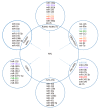Role of microRNA dysregulation in childhood acute leukemias: Diagnostics, monitoring and therapeutics: A comprehensive review
- PMID: 32855905
- PMCID: PMC7426929
- DOI: 10.5306/wjco.v11.i6.348
Role of microRNA dysregulation in childhood acute leukemias: Diagnostics, monitoring and therapeutics: A comprehensive review
Abstract
MicroRNAs (miRNAs) are short noncoding RNAs that regulate the expression of genes by sequence-specific binding to mRNA to either promote or block its translation; they can also act as tumor suppressors (e.g., let-7b, miR-29a, miR-99, mir-100, miR-155, and miR-181) and/or oncogenes (e.g., miR-29a, miR-125b, miR-143-p3, mir-155, miR-181, miR-183, miR-196b, and miR-223) in childhood acute leukemia (AL). Differentially expressed miRNAs are important factors associated with the initiation and progression of AL. As shown in many studies, they can be used as noninvasive diagnostic and prognostic biomarkers, which are useful in monitoring early stages of AL development or during therapy (e.g., miR-125b, miR-146b, miR-181c, and miR-4786), accurate classification of different cellular or molecular AL subgroups (e.g., let-7b, miR-98, miR-100, miR-128b, and miR-223), and identification and development of new therapeutic agents (e.g., mir-10, miR-125b, miR-203, miR-210, miR-335). Specific miRNA patterns have also been described for commonly used AL therapy drugs (e.g., miR-125b and miR-223 for doxorubicin, miR-335 and miR-1208 for prednisolone, and miR-203 for imatinib), uncovering miRNAs that are associated with treatment response. In the current review, the role of miRNAs in the development, progression, and therapy monitoring of pediatric ALs will be presented and discussed.
Keywords: Acute leukemia; Acute lymphoblastic leukemia; Acute myeloid leukemia; Biomarker; Classification; Drug resistance; MiRNome, MicroRNA; Prognosis.
©The Author(s) 2020. Published by Baishideng Publishing Group Inc. All rights reserved.
Conflict of interest statement
Conflict-of-interest statement: The author declares that there are no conflicts of interest.
Figures





Similar articles
-
Dysregulation of miRNA in Leukemia: Exploiting miRNA Expression Profiles as Biomarkers.Int J Mol Sci. 2021 Jul 2;22(13):7156. doi: 10.3390/ijms22137156. Int J Mol Sci. 2021. PMID: 34281210 Free PMC article. Review.
-
MicroRNA in leukemia: Tumor suppressors and oncogenes with prognostic potential.J Cell Physiol. 2019 Jun;234(6):8465-8486. doi: 10.1002/jcp.27776. Epub 2018 Dec 4. J Cell Physiol. 2019. PMID: 30515779 Review.
-
The Importance of Selected Dysregulated microRNAs in Diagnosis and Prognosis of Childhood B-Cell Precursor Acute Lymphoblastic Leukemia.Cancers (Basel). 2023 Jan 9;15(2):428. doi: 10.3390/cancers15020428. Cancers (Basel). 2023. PMID: 36672378 Free PMC article. Review.
-
MicroRNA as a diagnostic biomarker in childhood acute lymphoblastic leukemia; systematic review, meta-analysis and recommendations.Crit Rev Oncol Hematol. 2019 Apr;136:70-78. doi: 10.1016/j.critrevonc.2019.02.008. Epub 2019 Feb 23. Crit Rev Oncol Hematol. 2019. PMID: 30878131
-
miRNA and cancer; computational and experimental approaches.Curr Pharm Biotechnol. 2014;15(5):429. doi: 10.2174/138920101505140828161335. Curr Pharm Biotechnol. 2014. PMID: 25189575
Cited by
-
Use of extracellular vesicle microRNA profiles in patients with acute myeloid leukemia for the identification of novel biomarkers.PLoS One. 2024 Aug 23;19(8):e0306962. doi: 10.1371/journal.pone.0306962. eCollection 2024. PLoS One. 2024. PMID: 39178208 Free PMC article.
-
Expression Analysis of hsa-miR-181a-5p, hsa-miR-143-3p, hsa-miR-132-3p and hsa-miR-23a-3p as Biomarkers in Colorectal Cancer-Relationship to the Body Mass Index.Cancers (Basel). 2023 Jun 24;15(13):3324. doi: 10.3390/cancers15133324. Cancers (Basel). 2023. PMID: 37444431 Free PMC article.
-
Evaluation of MicroRNA92, MicroRNA638 in Acute Lymphoblastic Leukemia of Egyptian Children.Asian Pac J Cancer Prev. 2021 May 1;22(5):1567-1572. doi: 10.31557/APJCP.2021.22.5.1567. Asian Pac J Cancer Prev. 2021. PMID: 34048187 Free PMC article.
-
Exploring the interplay between microRNA expression and DNA mutation analysis in AML patients.Saudi J Biol Sci. 2024 Jul;31(7):104027. doi: 10.1016/j.sjbs.2024.104027. Epub 2024 May 21. Saudi J Biol Sci. 2024. PMID: 38831894 Free PMC article.
-
Dysregulation of miRNA in Leukemia: Exploiting miRNA Expression Profiles as Biomarkers.Int J Mol Sci. 2021 Jul 2;22(13):7156. doi: 10.3390/ijms22137156. Int J Mol Sci. 2021. PMID: 34281210 Free PMC article. Review.
References
Publication types
LinkOut - more resources
Full Text Sources
Research Materials
Miscellaneous

